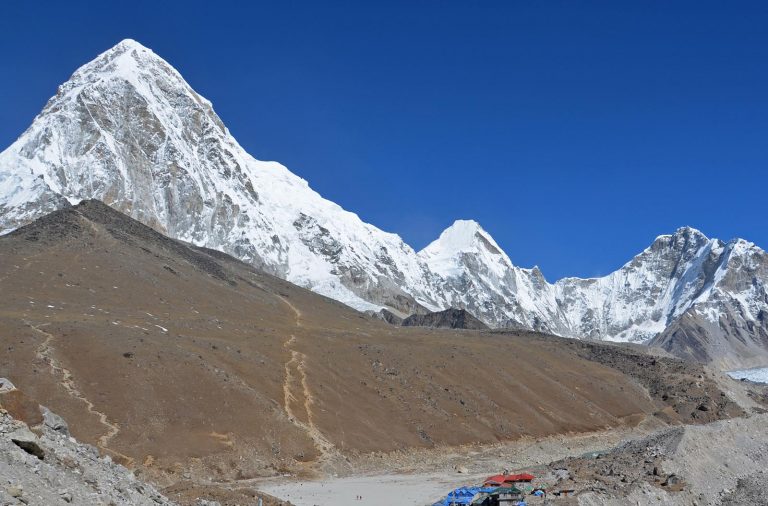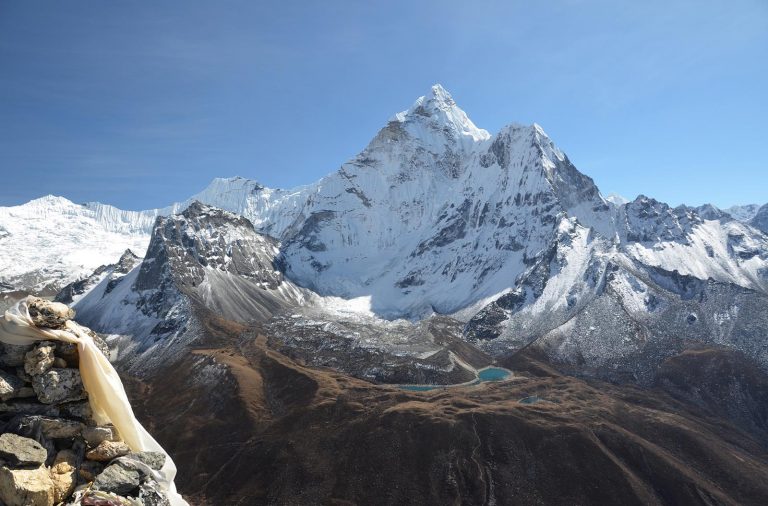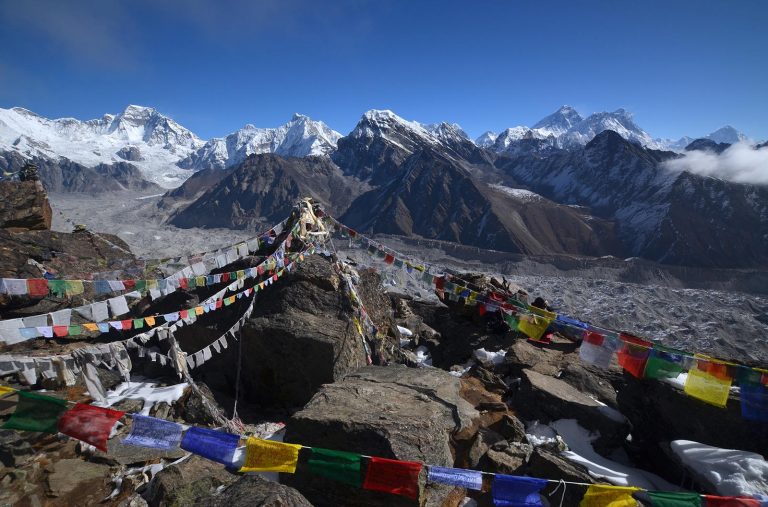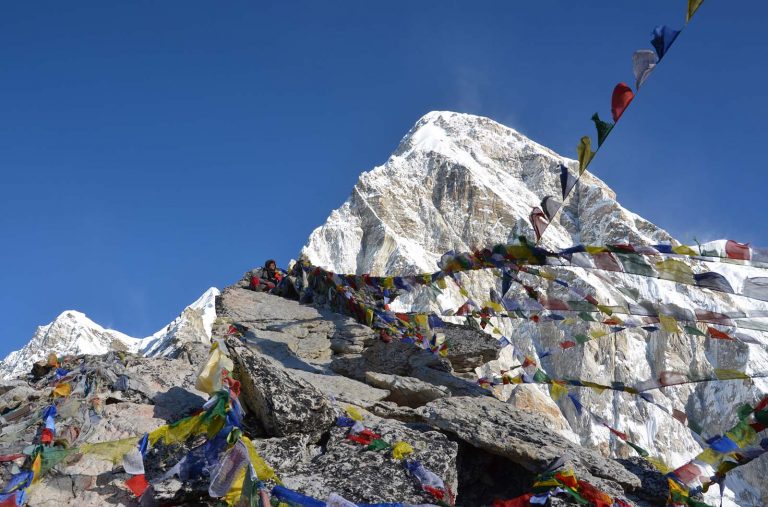Day 1 - A Precarious Landing
Start: Lukla (2,807 m), Goal: Phakding (2,633 m), Distance: 7 km, Duration: 4 hours
Just a small propeller plane and a 40 minute flight take you from Kathmandu to Lukla (2,840 m) – one of the most famous airports in the world. Due to its montane location, Lukla’s runway sits on a slight incline and spans a mere 600 meters.This causes planes to decelerate more strongly during landing, but also results in much faster take-offs. Taken together, it’s no wonder many consider Lukla to be one of the world’s most treacherous airports.
Lukla also serves as the starting point for most travelers and aspiring trekkers in the Khumbu region. Here, yaks are loaded, carriers are organized, and last-minute purchases are made. Once all is set, the adventure can begin.
Your first day of trekking to Mount Everest Base Camp consists of a 3 hour hike that ends in Phakding. The trail weaves through vibrant rhododendron and magnolia forests, passing many small villages and lodges where you can make contact with the local sherpa population. Phakding conveniently lies at an elevation just below Lukla’s (2,600 m), so you can ajust to the altitude with ease.
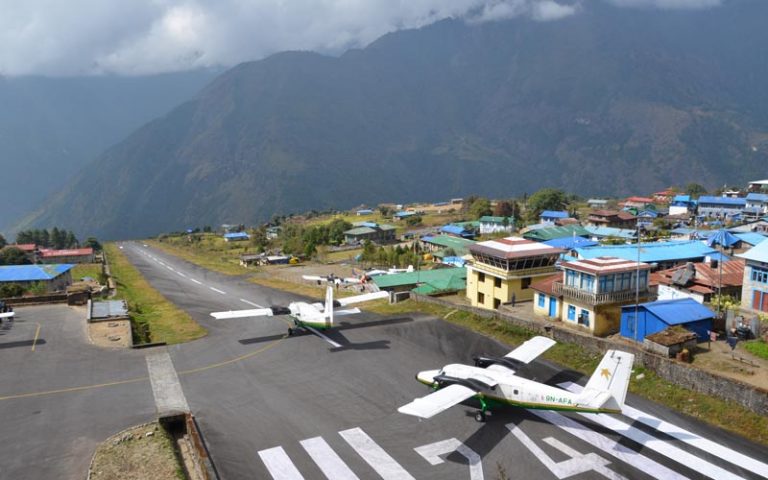
Day 2 - The First Step is Always the Hardest
Start: Phakding (2,633m), Goal: Namche Bazar (3,440 m), Distance: 10 km, Duration: 5 hours
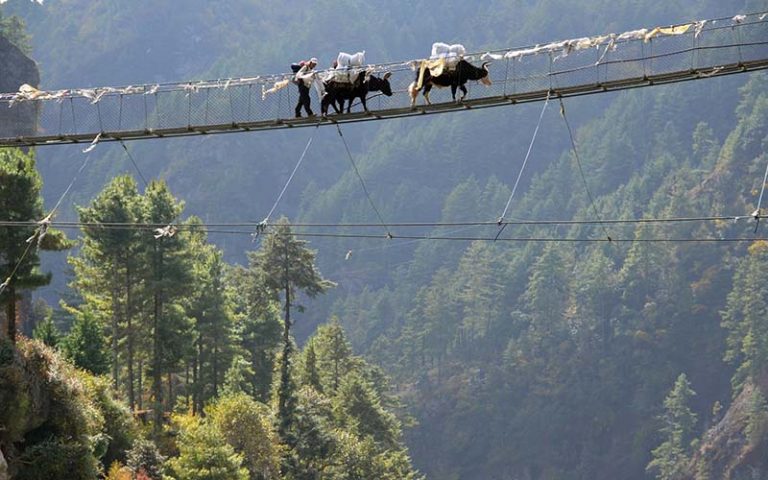
The trail from Phakding to Namche Bazaar marks the first test of your physical fitness.
After a 2 to 3 hour hike you will arrive at the border to Everest National Park. Entry requires a permit which should have already been acquired in Kathmandu and which will be requested by military personnel upon entering and exiting the national park. To avoid unnecessary hassle, please ensure you have it ready for the border control and stow it in a safe place during your travels.
Just beyond the entrance you will find the Everest-Guest-House. It is wise to take a break at this lodge as it is the last rest stop before Namche Bazaar. Further down the path comes the first and most thrilling of the trail’s suspension bridges: the Hillary Bridge. Once safely across, a steep ascent begins which should be taken slowly. The higher you climb, the more icy giants (e.g. Thamserku at 6,623 m) come into view.
Before you know it, the first houses of Namche Bazar (3,440 m) appear and you will have arrived in the village. Namche Bazaar lies protected in a caldera, where buildings stretch across the terraced hillsides. With its colorful roofs and bustling streets, the city makes a friendly impression and an ideal stop for an extra day of acclimatization.
Day 3 - Khumjung and Hot Tea
Start: Namche Bazaar (3,440 m), Goal: Tengboche (3,843 m), Distance: 8 km, Duration: 4 hours
Leaving Namche Bazaar, the trail continues deeper into the Khumbu valley, towards the well-known Tengboche monastery. This path takes you to Khumjung, which is the Sherpa’s unofficial capital city.
Khumjung lies along many hiking routes in this region, so accommodation and shops that cater to trekking and mountaineers are abundant here. Alongside the local bank, post office and dental clinic, you will also find several internet cafes, an administrative center for the Khumbu region and Sagarmatha National Park and a short runway (although this is currently used for medical emergencies only).
Those who resist the town’s hustle and bustle will be in Tengboche in about 2-3 hours. This is the religious center of the Khumbu region and home to a Buddhist monastery with the largest temple in the region. The original structure was built in 1923, and was rebuilt following a fire in 1989.
The interested traveler can attend the daily ceremony given by the monks. After the prayers, one will hand out hot tea. Shortly thereafter, a monk will sound a horn which cues to the other monks to accompany him on various instruments. For newcomers, the action can be somewhat difficult to follow, but is undoubtedly exciting to witness, nonetheless.
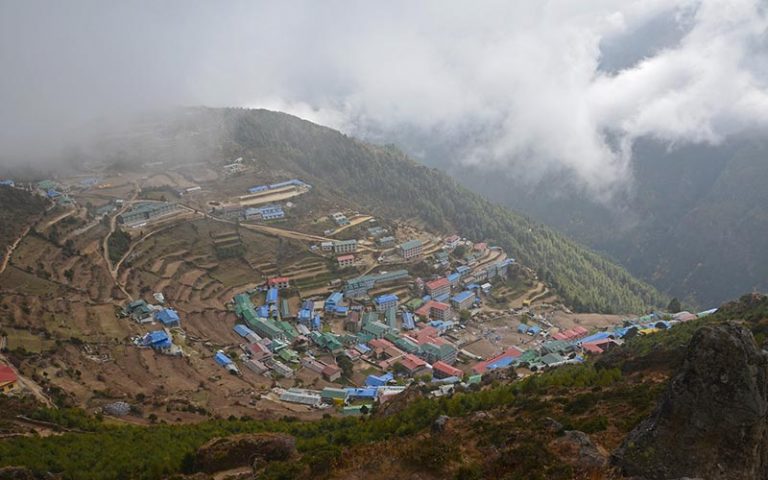
Day 4 - Crossing the Treeline
Start: Tengboche (3,843 m), Goal: Pheriche (4,238 m), Distance: 10 km, Duration: 5 hours
As of Tengboche, the trail runs parallel to the Imja Khala River and on towards Pangboche. Although you could carry on directly to Pheriche after a short rest, the monastery in the upper part of town is well worth a quick visit. It is the oldest monastery in the valley and has been well kept. It is looked after by a sole monk who takes on this stewardship for a year before passing the responsibility on to another.
Heading on from Pangboche, the path climbs steadily and with each step, the landscape changes more and more rapidly. You will also notice the vegetation dwindling and temperatures dropping with the increase in altitude. After reaching the highest point of about 4,280 meters, a final walk downhill leads you to Pheriche.
The village is very modest and does not offer much in terms of shopping, but it does have a clinic that provides medical care. Pheriche also lies in a scenic region on the river, surrounded by many peaks towering over 6,000 meters high.
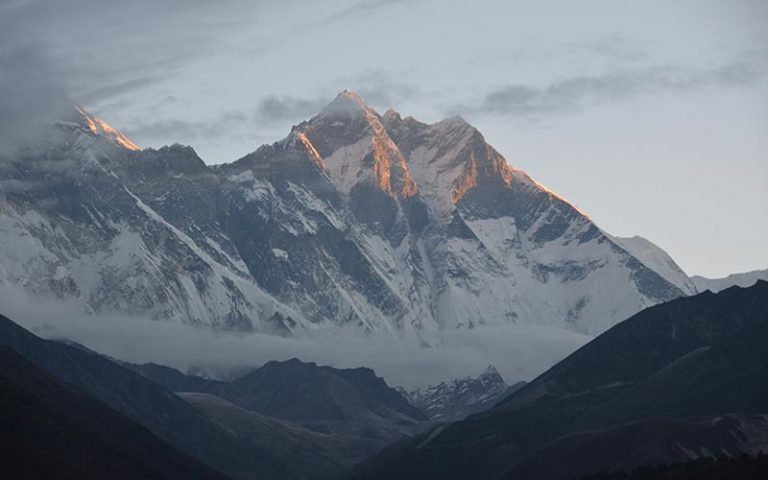
Day 5 - Memorials to the Fallen
Start: Pheriche (4,238 m), Goal: Lobuche (4,930 m), Distance: 8 km, Duration: 4 hours
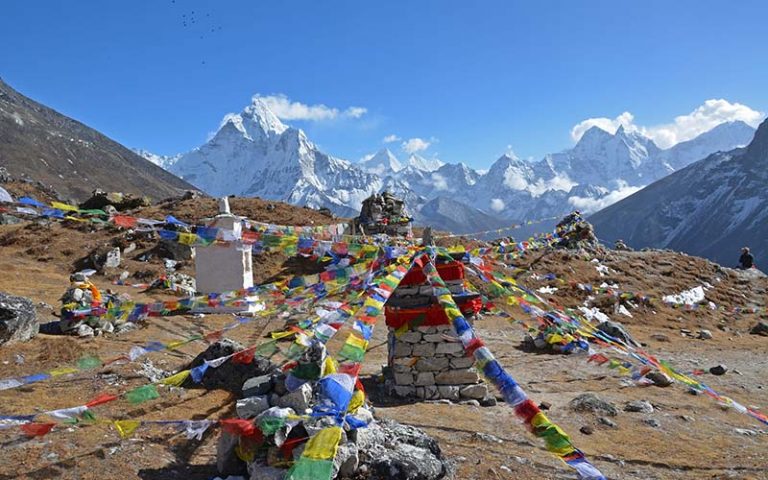
As of Pheriche, the trail continues up on to a ridge. The slope is traversed at a more or less consistent elevation and takes you to Tughla (4,620 m), where you can take a drink break. From here on, the track starts a steep ascent towards Khumbu glacier.
After the first hard climb you will likely come across “Khagan chorten” (Khanggani = door), which were originally built for fallen Everest victims and serve to cleanse travelers of evil spirits and demons. Amongst these, you will also find a memorial for the American, Scott Fischer, who lost his life in the tragic events of May 1996. After a final push, you reach a small pass, the hike relaxes into a gradual incline and you arrive in Lobuche at a height of 4,930 meters.
Day 6 - Khumbu Glacier
Start: Lobuche (4,930 m), Goal: Gorak Shep (5,171 m), Distance: 4 km, Duration: 3 hours
The trail from Lobuche to Gorak Shep rises steadily but also consistently. The thin air will also become more and more apparent and you will naturally walk much more slowly. Nevertheless, you should reach Gorak Shep (5,164 m) in about 2-3 hours. This path also follows the edge of the Khumbu glacier, although you may not recognize it at first. A blanket of gravel and stones initially obscures its tongue from view but subsides the further along you go; the farther you hike, the more ice is revealed.
Gorak Shep is the last permanently inhabited settlement on the slopes of Mount Everest and is named after the region’s Gorak chickens. The village consists of a few simple lodges and marks a natural starting point for the ascent to Everest Base Camp. Its location also lends itself as the starting point for Kala Patthar – a well-known and very popular peak with a view out to Mount Everest.
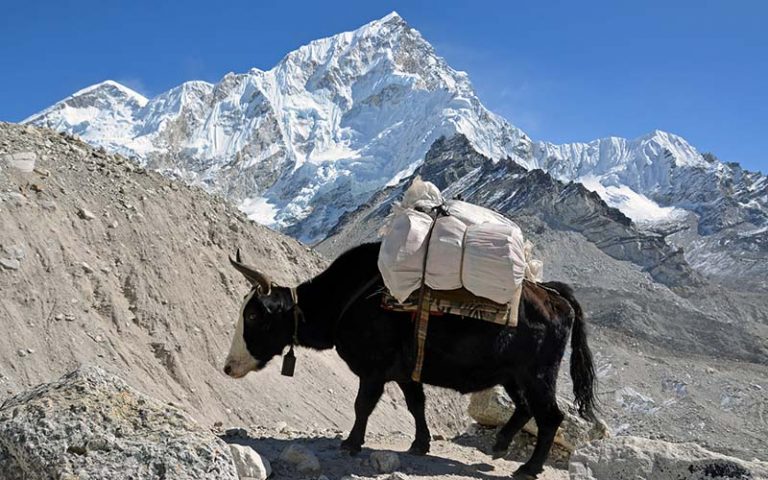
Day 7 - Everest Ahoy
Start: Gorak Shep (5,171 m), Goal: Khala Patthar (5,545 m) Distance: 10 km, Duration: 5 hours
From Gorak Shep, one can climb the 5,545 meter high Khala Patthar. The name Khala Patthar means “Black Stone”. Khala Patthar is not officially recognized as a mountain in Nepal, thanks to its relatively low elevation and its position as a smaller peak on the ridge to neighboring Pumori (7,167 m). Even still, the route is one of the most popular peaks for many visitors and various trekking companies. The full climb from Gorak Shep should take about 2 hours.
Along the way, a number of landings allow for rests, but the climb consists predominantly of steep inclines. Although the hike traverses through a mere 400 meters of altitude, you should also expect to feel a sobering reminder of your position above 5,000 meters with every step you take. Once you arrive at Khala Patthar’s peak, you will be rewarded with an excellent view of the west side of Mount Everest, the north wall and the west ridge.
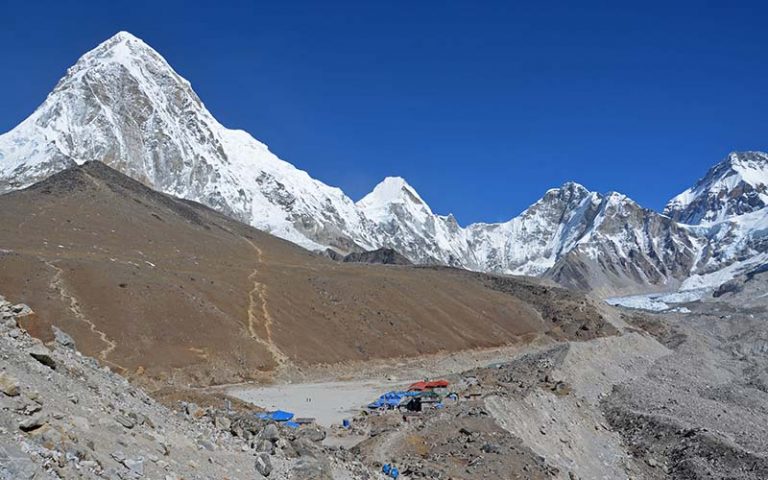
Day 8 - Home Sweet Home
Start: Gorak Shep (5,171 m), Goal: Everest Base Camp (5,400 m), Distance: 4 km, Duration: 4 hours
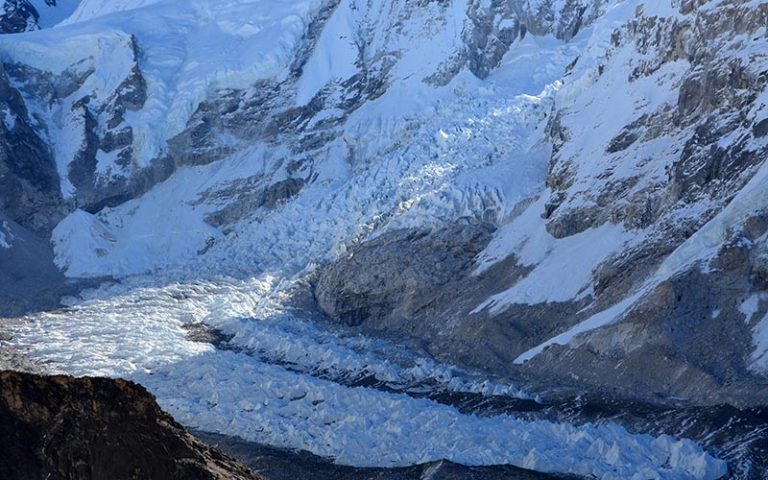
The final day’s trek follows Khumbu glacier’s river to Everest Base Camp. The base camp is located at almost 5,400 meters and is the starting point for the ascent to Mount Everest along the southern route.
The most famous base camp in the world lies about 2 hours from Gorak Shep along a gradual, but exhausting path. The trail continuously rises and falls, weaving through Khumbu’s many lateral moraines and taking you toward the valley’s end.
Along the way, a number of memorials for further victims of the 1996 Everest tragedy come into view. Personal chorten built for famous climbers such as Rob Hall and Andy Harris are also nearby. To visit them, take a short, 15-minute side trip uphill. For those with a few more minutes to spare, a spread of many more memorials awaits along the hill.
Soon after you set out for Base Camp, a colorful arrangement of tents will materialize in the distance. After descending the lateral moraine to the actual glacier, the first tents will officially lay in front of you, followed by the expansive camp ground at nearly 5,400 meters. Most returning expeditions are located here during the peak season, and have fenced off their own area. Many of these have also constructed their own small stupas and decorated them with colorful prayer flags.

